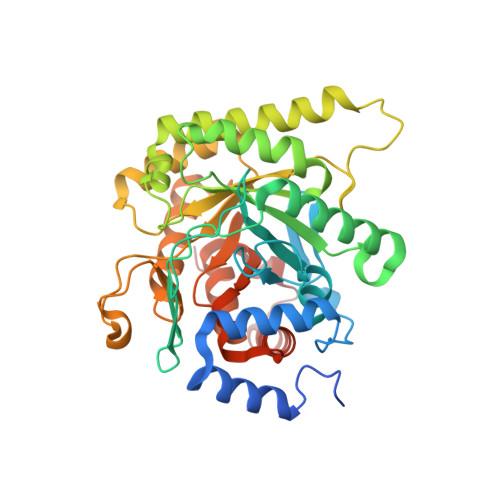Potent Antimalarials with Development Potential Identified by Structure-Guided Computational Optimization of a Pyrrole-Based Dihydroorotate Dehydrogenase Inhibitor Series.
Palmer, M.J., Deng, X., Watts, S., Krilov, G., Gerasyuto, A., Kokkonda, S., El Mazouni, F., White, J., White, K.L., Striepen, J., Bath, J., Schindler, K.A., Yeo, T., Shackleford, D.M., Mok, S., Deni, I., Lawong, A., Huang, A., Chen, G., Wang, W., Jayaseelan, J., Katneni, K., Patil, R., Saunders, J., Shahi, S.P., Chittimalla, R., Angulo-Barturen, I., Jimenez-Diaz, M.B., Wittlin, S., Tumwebaze, P.K., Rosenthal, P.J., Cooper, R.A., Aguiar, A.C.C., Guido, R.V.C., Pereira, D.B., Mittal, N., Winzeler, E.A., Tomchick, D.R., Laleu, B., Burrows, J.N., Rathod, P.K., Fidock, D.A., Charman, S.A., Phillips, M.A.(2021) J Med Chem 64: 6085-6136
- PubMed: 33876936
- DOI: https://doi.org/10.1021/acs.jmedchem.1c00173
- Primary Citation of Related Structures:
7KYK, 7KYV, 7KYY, 7KZ4, 7KZY, 7L01, 7L0K - PubMed Abstract:
Dihydroorotate dehydrogenase (DHODH) has been clinically validated as a target for the development of new antimalarials. Experience with clinical candidate triazolopyrimidine DSM265 ( 1 ) suggested that DHODH inhibitors have great potential for use in prophylaxis, which represents an unmet need in the malaria drug discovery portfolio for endemic countries, particularly in areas of high transmission in Africa. We describe a structure-based computationally driven lead optimization program of a pyrrole-based series of DHODH inhibitors, leading to the discovery of two candidates for potential advancement to preclinical development. These compounds have improved physicochemical properties over prior series frontrunners and they show no time-dependent CYP inhibition, characteristic of earlier compounds. Frontrunners have potent antimalarial activity in vitro against blood and liver schizont stages and show good efficacy in Plasmodium falciparum SCID mouse models. They are equally active against P. falciparum and Plasmodium vivax field isolates and are selective for Plasmodium DHODHs versus mammalian enzymes.
- Medicines for Malaria Venture, 1215 Geneva, Switzerland.
Organizational Affiliation:




















